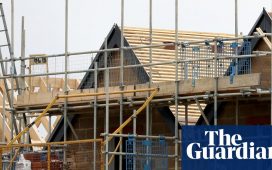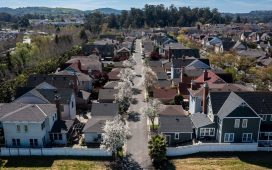Stay informed with free updates
Simply sign up to the UK property myFT Digest — delivered directly to your inbox.
Owners of flats are struggling to take the next step up the property ladder, as sluggish demand for the property type leaves many homes worth less than their purchase value.
Over the past three years, flat sales are 25-33 per cent down on what would have been expected if owners could sell for more than they originally paid, according to analysis from estate agent Hamptons.
Flat values had stagnated since 2015-16, Hamptons said, so owners had to wait longer to build sufficient equity for an onward move. It estimated that 400,000 fewer flat owners in England and Wales will have moved by the end of this year compared with a scenario in which their home’s value continued to rise.
Aneisha Beveridge, research director at Hamptons, said the analysis underlined the importance of price growth in facilitating transactions. “Flat owners have faced a raft of challenges over the past decade, all of which have limited some households’ ability to move. Arguably, the biggest factor is the lack of price growth for these property types.
“Flat values have also been damped by the post-Covid race for space, which reduced demand for these homes. In some cases, owners have also had to battle with cladding and leasehold issues.”
The researchers looked at owners of flats who advertised their homes for sale between 2015 and 2024, knowing what they paid originally and how much they were subsequently asking for. It was then able to estimate the additional sales that would have happened if homes marketed at, or below, their original purchase price had sold at the same rate as those that had seen an uplift in value.
The agent acknowledged that some owners sold up and moved, regardless of a shortfall in value. But its data suggested that those looking at a potential loss were around half as likely to proceed with a sale compared with those who could at least break even.
Transaction costs such as stamp duty weigh on sellers’ ability to show a profit, and high mortgage costs in recent years have magnified the risks of making a move.
Average house prices have risen by 28 per cent since 2018, but Hamptons said flat price growth was lagging at 13 per cent over the same period. In some areas, it added, average prices of flats had fallen. As a result, while 90 per cent of sellers (of both flats and houses) in the year to date had sold for more than they paid, the figure was about 75 per cent for flat sellers.
Many owners market their flats as a test of market demand and value before they fully commit to a sale. Hamptons’ data on advertised prices suggested 25 per cent of those who bought a flat five years ago had put their home on the market for less than they originally paid. In London, the figure is 30 per cent.
The capital city — the most expensive UK location — has seen substantial price falls in recent years. In the year to April, the average value of a London home fell by 3.9 per cent to £501,880 — the biggest drop of any region and counter to UK average growth of 1.1 per cent, according to the ONS house price index. London flat owners are more likely to have been hit by cladding issues, too, given the relatively large size of blocks in the capital.

“Concerns over building safety for some new build flats has compounded the problems of leasehold and the associated costs of service charges and ground rents,” said Richard Donnell, research director at property site Zoopla. “But the flats market is very segmented and some of these risks don’t apply, so for the canny buyer there is some good value for money to be tapped in the flats market.”
As the Bank of England cut its official interest rate this week, giving a confidence boost to mortgage borrowers, Beveridge said flat owners struggling to move may find their difficulties easing.
“We expect pent-up demand from flat owners to begin unwinding, slowly driving up transaction levels. Primarily this will be market driven, with numbers buoyed by some price growth across the south of the country as interest rates fall,” she said.
This shift in sentiment may be bolstered by Labour’s plans to reform leasehold, a common means of ownership for flats. Its manifesto pledged to “bring the feudal leasehold system to an end”, ban the use of leasehold contracts for new flats and tackle “unregulated and unaffordable” ground rent charges.










